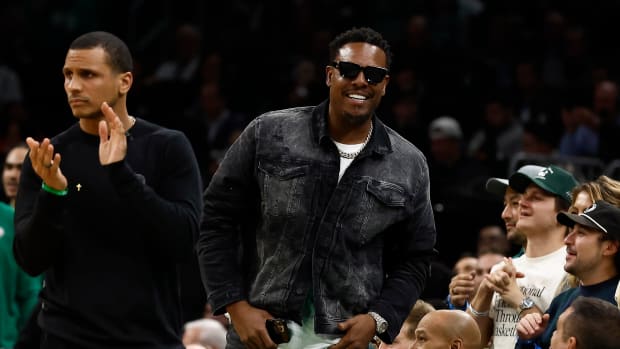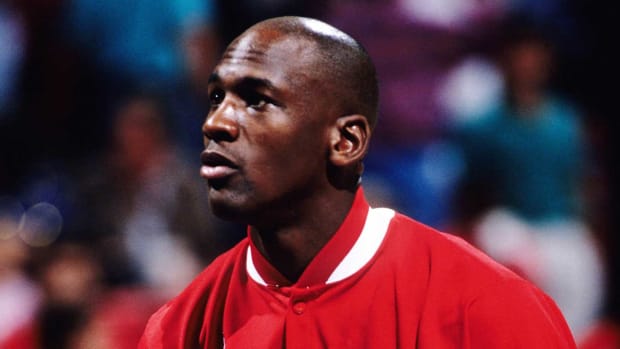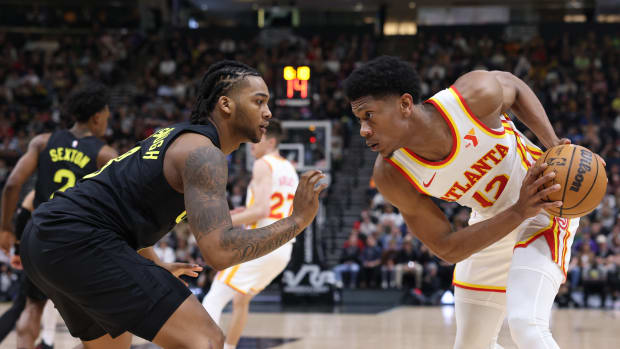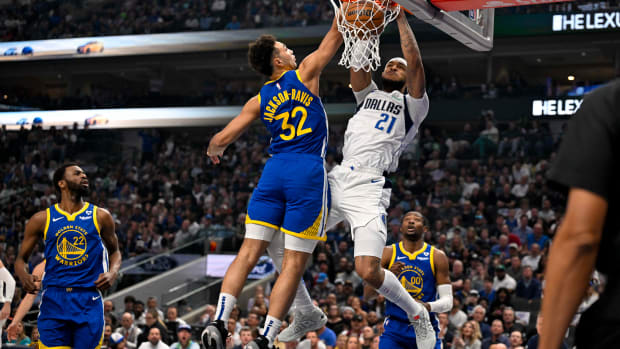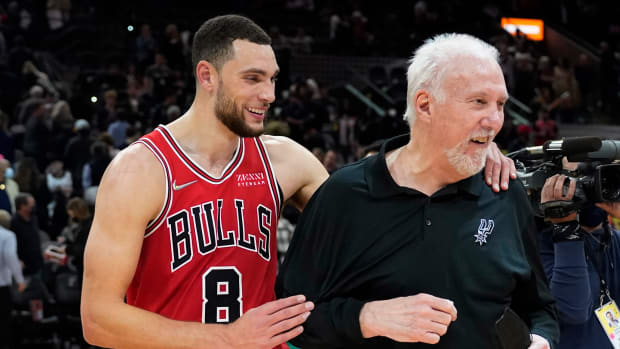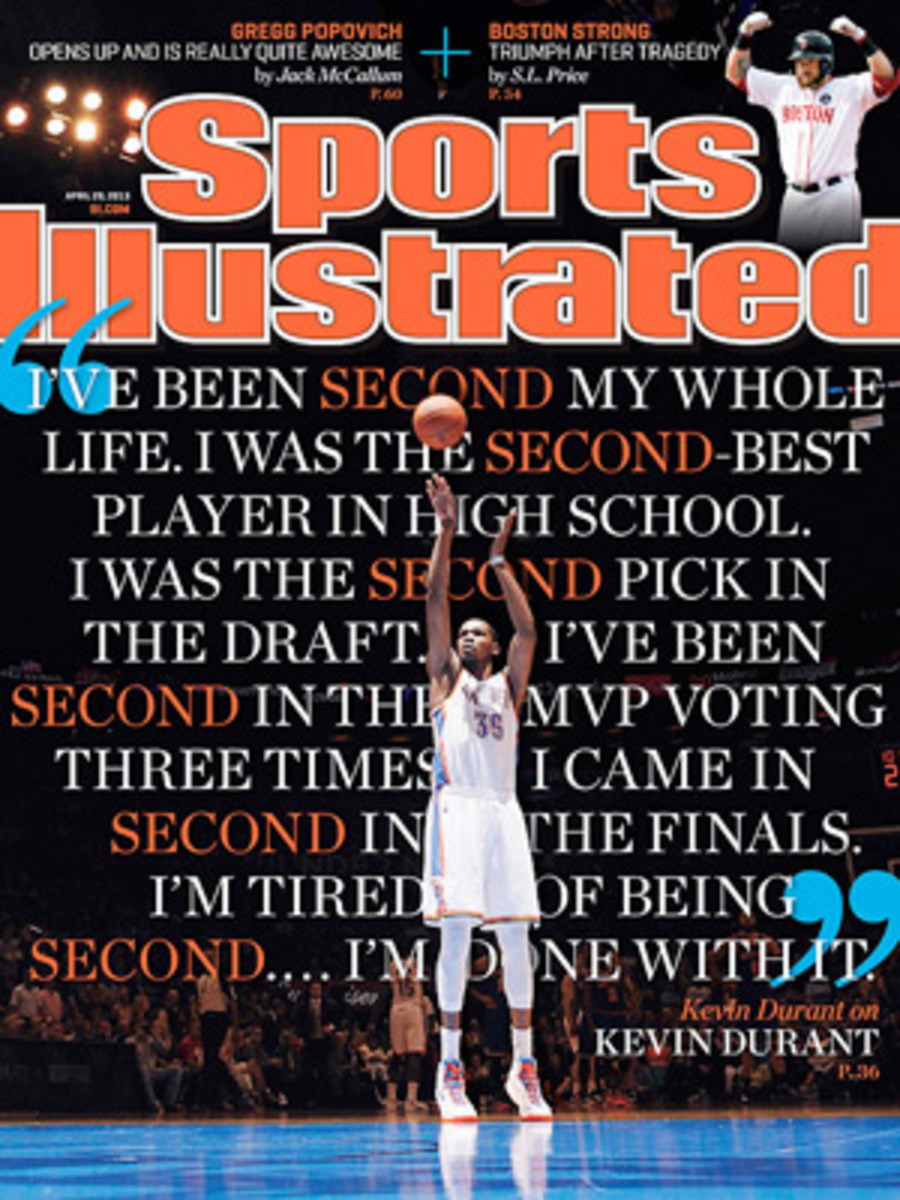
Kevin Durant sick of second, working for first with help of advanced stats
Kevin Durant appears on the cover of this week's Sports Illustrated. (Greg Nelson/SI)
You have reached your limit of 4 premium articles
Register your email to get 1 more
This week's Sports Illustrated cover features Thunder forward Kevin Durant, surrounded by his words that read, at first, like a venting promise.
“I’ve been second my whole life,” Durant tells SI's Lee Jenkins in a profile that will hit newsstands on Thursday. “I was the second-best player in high school. I was the second pick in the draft. I’ve been second in the MVP voting three times. I came in second in the Finals. I’m tired of being second. I’m not going to settle for that. I’m done with it.”
That quote perfectly sums up the inherent frustration involved in operating at the highest of levels in LeBron James' world. Is anything ever good enough when James keeps raising the bar?
But Jenkins' profile reveals a Durant who has fully embraced that frustration as a means to self-improvement. There isn't a hint of "woe is me" whining in Durant's declaration; he's too busy searching for ways to reach the summit.
That process includes first-hand observation of James, a study that has unfolded over multiple years, drifted into the world of advanced statistics and resulted in a friendship, but one that has only fueled their competitive tension.
“That’s my guy,” Durant says. “I looked up to him [James], and now I battle him.”
...
“I don’t watch a lot of other basketball away from the gym,” Durant says. “But I do look at LeBron’s box score. I want to see how many points, rebounds and assists he had, and how he shot from the field. If he had 30 points, nine rebounds and eight assists, I can tell you exactly how he did it, what type of shots he made and who he passed to.” Durant and James take flak for their friendship, but it is based on a mutual appreciation of the craft. They aren’t hanging out at the club. They are feverishly one-upping each other from afar. “People see two young black basketball players at the top of their game and think we should clash,” Durant says. “They want the conflict. They want the hate. They forget Bird cried for Magic. A friend was getting on me about this recently, and I said, ‘Calm down. I’m not taking it easy on him. Don’t you know I’m trying to destroy the guy every time I go on the court?’ ”
It's one thing to pay lip service to the shot charts and numbers; it's quite another to employ a personal stat geek and to memorize situational shooting statistics. Durant, we find out, has done both of those things, and more.
Kevin Durant sat in a leather terminal chair next to a practice court and pointed toward the 90-degree- angle at the upper-right corner of the key that represents the elbow. “See that spot,” Durant said. “I used to shoot 38, 39 percent from there off the catch coming around pin-down screens.” He paused for emphasis. “I’m up to 45, 46 percent now.”
...
Durant has hired his own analytics expert. He tailors workouts to remedy numerical imbalances. He harps on efficiency more than a Prius dealer. To Durant, basketball is an orchard, and every shot an apple. “Let’s say you’ve got 40 apples on your tree,” Durant explains. “I could eat about 30 of them, but I’ve begun limiting myself to 15 or 16. Let’s take the wide-open three and the post-up at the nail. Those are good apples. Let’s throw out the pull-up three in transition and the step-back fadeaway. Those are rotten apples. The three at the top of the circle -- that’s an in-between apple. We only want the very best on the tree.”
The takeaway feeling is that Durant exists these days entirely within the "edge" that elite athletes often talk about, and it's enough to make you wonder how he stays sane, given James' all-encompassing dominance, and whether the mean streak he's shown this season is a negative by-product of all that built-up tension. Jenkins explores, concluding that Durant hasn't fundamentally changed, even if he has evolved.
Previously, if power forward Serge Ibaka blew a box-out, Durant would tell him, “It’s O.K. You’re going to get it next time.” But the stakes had risen. “You want to get to the Finals again, and you think everything should be perfect, and it’s not,” Durant says. “So I’d scream at him and pump my fist.”
Durant has picked up 12 technical fouls this season, more than twice as many as his previous career high, and he was ejected for the first time, in January, after arguing with referee Danny Crawford. “I’m rubbing off on him,” says Thunder center Kendrick Perkins, who keeps a standing 2 a.m. phone call with Durant every night to discuss the state of the team. “He’s getting a little edge on.” The techs dovetailed neatly with Nike’s “KD is Not Nice” marketing campaign, but they still don’t fit the recipient. Even after the ejection, Durant stopped to high-five kids sitting over the tunnel. “People get it confused and think you have to be a jerk to win,” he says. “But we all feed off positive energy. I’m a nice guy. I enjoy making people happy and brightening their day. If someone asks me for an autograph on the street, I don’t want to wave him off and tell him, ‘Hell, no.’ That’s not me. The last few months I’ve calmed down and had more fun. We can still get on each other, but there’s another way.”
Sports Illustrated
this podcast
SI































